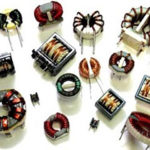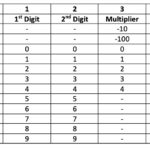In the previous tutorials, we discussed the basic concept of an inductor, properties of an inductor, and different types of inductors. Now it’s time to know how to select an inductor for a given circuit. Fortunately, different types of inductors are designed to suit specific applications. So, for any given application, either there is exclusively a particular type of inductor available, or there are, at the most, two or three types to choose from. Check out the previous article to learn about different types of inductors and their applications. For most of the common applications, solenoidal coils, toroids, or pot cores are preferred. To select from these, the following considerations are important:
- If the circuit requires the use of multiple inductors that should have or can have some mutual inductance, solenoidal coils can be used. The solenoidal coils are inexpensive, widely available, and easy to design and troubleshoot. However, solenoidal coils are usually quite bulky compared to other inductor types. Still, these can be preferred in the first place if electromagnetic interference or mutual inductance is not an important concern of the circuit.
- If the circuit requires having no mutual inductance or there should be no electromagnetic interference of the inductor with any other component in the circuit, toroids should be first preferred. Toroids are small in size, pack high value of inductance, and have almost no electromagnetic interference. If the mutual inductance is desired between different coils, they can be wound on the same core.
- Pot Cores offer similar advantages as the toroids. However, these are quite expensive due to their complex construction. It is not easy to find pot cores for high power applications. Pot cores also have limited exposure for air circulation so that they may face heating issues. Still, pot cores are much robust, offer better shielding, and can be more easily mounted to printed circuit boards.
In the selection of an inductor for a given circuit, choosing the type of inductor is quite straight forward. The important concerns in the selection of an inductor are always the desired characteristics. Firstly, for any circuit, a desired value of inductance is either given or needs to be derived by the engineer. An inductor of the same nominal value needs to be picked. The next important thing that needs to be considered is tolerance. It should be checked what variation in inductance will not affect the performance of the circuit. Accordingly, an inductor with suitable tolerance must be picked.
The rest of the parameters can be circuit- or application-specific. Essentially, it is important to check out for the saturation current of the selected inductor. The saturation current of the inductor chosen should be at least 1.5 times or twice the DC or RMS current levels the inductor might be exposed to in the circuit. To ensure the desired performance of the inductor, incremental current and maximum DC current should also be checked. The factors like saturation current, incremental current, and maximum DC current plays a crucial role, particularly when the selected inductor has a ferrite core.
If the circuit needs to be very power efficient like in coupling applications or power supply circuits, DC resistance, impedance, and quality factor are important properties to make a check. Similarly, in frequency sensitive circuits like the filter circuits, the self-resonant frequency of the inductor plays an important role. Likewise, in temperature-sensitive circuits, inductance temperature coefficient, resistance temperature coefficient, ambient temperature range, operating temperature range, and Curie temperature are important factors that must be essentially checked. The issue of electromagnetic interference can be sorted out most of the time by choosing the right inductor type, i.e., toroid or pot core, if EMI has to be avoided.
Standard Values of inductors
Like resistors and capacitors, inductors also come available in standard values, according to E-Series. For learning more about standard values of resistors, capacitors, inductors, and Zener diodes, check out the following article, “Basic Electronics 08 – Reading Value, Tolerance and Power Rating of Resistors“.
Series and parallel combination of inductors
It may not be possible to get the exact value of the required inductance at all times. In such a case, a series or parallel combination of inductors can be used to get the desired inductance. When the inductors are connected in series, their equivalent inductance is the sum of inductances as follows:
LSeries = L1 + L2 + L3 + . . . .
When the inductors are connected in parallel, their equivalent inductance is given by the following equation:
1/LParallel = 1/L1 + 1/L2 + 1/L3 + . . . .
The equation for the series combination of inductances is derived from the fact that the sum of voltage drops across all the inductors connected in series will be equal to the applied voltage while the same current passes through all the inductors in the branch. The equation for the series combination of inductances is derived in the following way:
VTotal = VL1 + VL2 + VL3 + . . . .
-LSeries * di/dt = -L1 * di/dt + (-L2 * di/dt) + (-L3 * di/dt) + . . . .
LSeries = L1 + L2 + L3 + . . . .
The equation for parallel combination of inductances is derived from the fact that the sum of the currents through all the inductances connected in parallel will be equal to the total current while voltage across them shall remain the same. The equation for parallel combination of inductances is derived in the following way –
I = i1 + i2 + i3 + . . . .
1/LParallel * ∫V.dt = 1/L1 * ∫V.dt + 1/L2 * ∫V.dt + 1/L3 * ∫V.dt + . . . . .
1/LParallel = 1/L1 + 1/L2 + 1/L3 + . . . .
The above equations are derived, considering that the inductors do not have any mutual inductance.
Mutual inductance
Practically, all inductors have some mutual inductance. The electromagnetic interference is much apparent in the case of solenoidal coils, while toroids, pot cores, and transmission line inductors are well shielded to show any significant mutual inductance. The mutual inductance between two inductors depends upon the value of their inductance and the coefficient of coupling between them. It is measured in the same unit as inductance and is denoted by the letter ‘M’. The following equation gives the value of mutual inductance between two inductors –
M = k*(L1*L2)1/2
Here, k is the coefficient of coupling. It can have a value from 0 to 1. If two inductors are well shielded and have no electromagnetic interference, the value of k is 0, and there is zero mutual inductance between the inductors.
Mutual inductance is much apparent when inductors (particularly solenoidal coils) are connected in series. The mutual inductance can be additive or subtractive. When the inductors are connected close to each other such that current flows through them in the same direction, they reinforce the magnetic fields of each other. So, the mutual inductance is additive in such case. The following equation gives the effective inductance in such case –
L = L1 + L2 + 2M = L1 + L2 + 2* k*(L1*L2)1/2
When inductors are connected close to each other such that current flows through them in opposite directions, the magnetic fields through the inductors oppose the magnetic fields of each other. In such a case, the mutual inductance is subtractive. The effective inductance, then, is given by the following equation –
L = L1 + L2 – 2M = L1 + L2 – 2* k*(L1*L2)1/2
In the next article, we will discuss reading inductor packages.
You may also like:
Filed Under: Tutorials








Questions related to this article?
👉Ask and discuss on EDAboard.com and Electro-Tech-Online.com forums.
Tell Us What You Think!!
You must be logged in to post a comment.